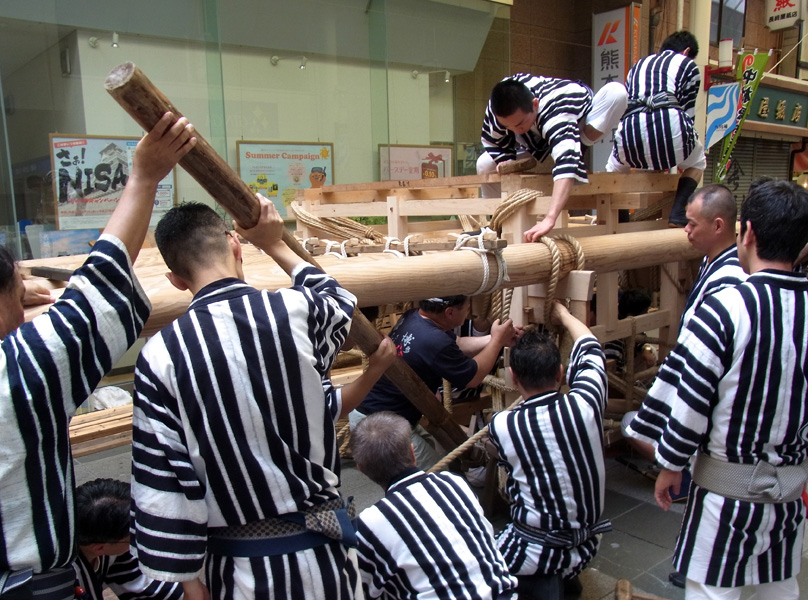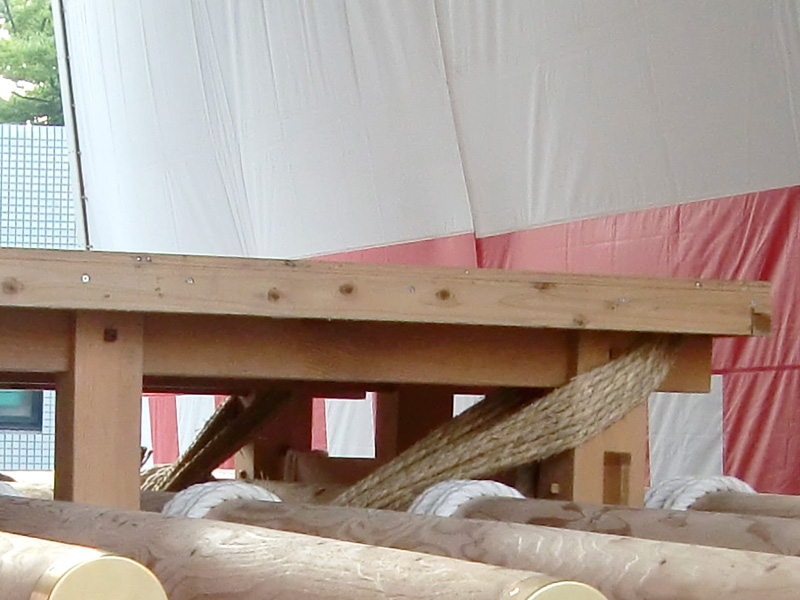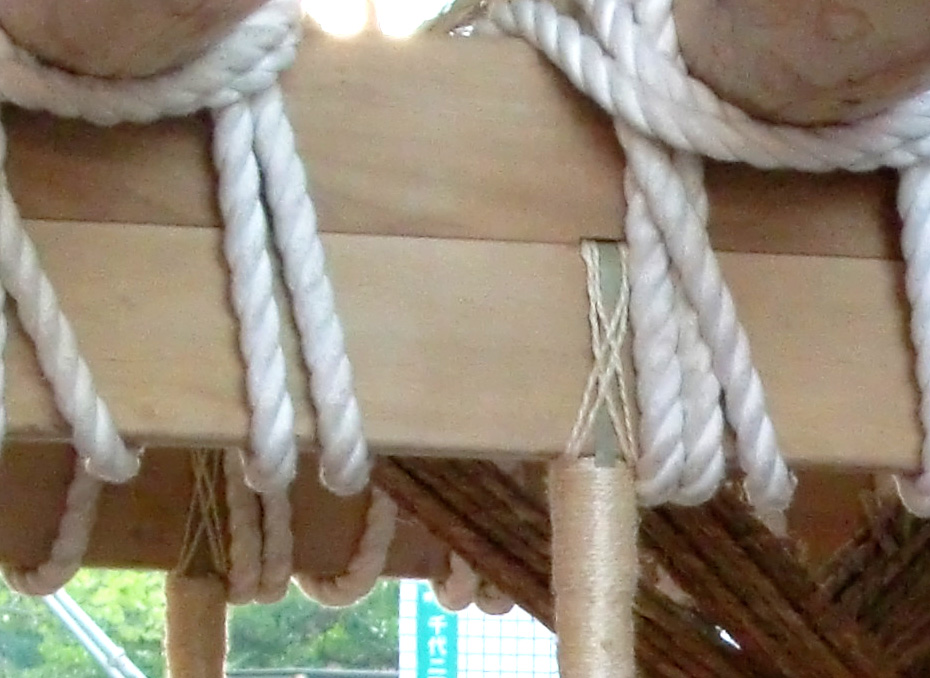This ritual is carried out in early june before the Kakiyama get assembled. The six sturdy carrying poles, that are reused each year, must be washed with sea water at the Kushida sub-shrine by the ocean.


Yamakasas Traditional Arts
More on the beauty and craftsmanship of the Handbarrows
Kakiyama Framework

The Kakiyama must withstand alot of force when beeing carried by about 30 men through the city. It is therefore very astonishing, that the whole frame is built without nails and solely out of wood and rope. The techniques used to make this possible have been given down from generation to generation and are a wonder of craftsmanship.
Building the Kakiyama after the strict traditional rules.
Since the Hakata-Gion-Yamakasa is a religious festival and the Kakiyama will be offered to the Kushida-shrine, there are multiple ceremonies aroung the building of the Kakiyama.
First step before the assembling: The washing of the carrying poles.

Public prayer for the safety of the building and displaying of the Kakiyama and Kazariyama

At the location, where the Kakiyama will be built, a small ceremony is held and the parts of the Kakiyama are blessed. After the ceremony, the carpenters will assemble the basic framework without using a single nail.
The fixing of the carrying poles

The poles are fixed to the framework using only two about 40 metre long ropes. The rope has to be very tightly wound around the poles, which is achieved by using a long pole and using it as a lever to bring up the nescessary force. The rope is tightened until the wood starts to creak under the extreme pressure, indicating that the frame is finished. The exact binding technique is given down through the generations and has been used for centuries.
The frames structure and name

Shiori 枝折

This is the top of the Kakiyama, where the decoration is later placed. Both at the front and the back about 40cm will be left free for the poeple sitting of the Kakiyama and firing the carriers on.
Bōjime-nawa 棒〆縄

The strong hemp rope, that fixes the poles to the frame but also acts as a buffer material between the two.
Bō 棒

Sturdy poles out of cypress or cedar. Every Kakiyama has six of them with the outer most two called “first bar”, the ones a bit further in called “second bar” and the middle two called “third bar”. They are further identified by the side they are on with the right side referred to as “right shoulder” and the left side as “left shoulder”.
Bōhana 棒鼻

The carrying poles have brass rings on either end to keep the wood from splitting and allowing an easyier grip for the carriers. Before the run of the Kakiyama small leghts of rope, that the carroers can grasp, will be fixed with help of these rings.
Bōguri 棒ぐり

Molds for the carrying poles. The wood, on which the poles rest has semicirular molds for the poles not to slip out of place.
Bōuke 棒受け

The part of the framework, on which the poles rest. The poles are fixed to this central part of the framework, that is made of strong cherry or cypress wood.
Yatsumojinawa 八つ文字縄

The eight character Binding. A large amount of force is exerted on the whole structure of the Kakiyama during the runs. The Kakiyama not using a single nail but being held together by hemp rope, the shocks need to be absorbed. This is done by a connection of all corners of the frame with the diagonal one by several lengths of rope. To our knowledge the Kakiyama have always been build with this connection of the eight inner frame corners.
He-no-Ji への字

The “he” chatracter. The bent beams between the both the front and the back legs of the Kakiyama are there for stability and to allow a toppled over carriers to dive under the lower frame of the Kakiyama. Because the lower edge of the frame looks like the Symbol for “he” in the Japanese Hiragana alphabet, it is called “He-no-ji” (Character of “he”).
Hiuchi 火打ち

The binding between the four legs of the kakiyama used to further reinforce it.
Dōgane 胴がね

The Kakiyama foot. The feet of the Kakiyama have iron covers in order to protect from damage when standing or being accidentaly pulled along the ground. This happens quite often and when the ground beneath the Kakiyama is dry, you can see sparks coming from the feet as they are dragged over the concrete.
Bibliographical reference
- Osshoi! Yamakasa (Kiyosuke Ishibashi Kikigaki-Hosaka AkiraTakashi Author) [Nishinippon Shimbun]
おっしょい!山笠(石橋清助 聞書・保坂晃孝 著)[西日本新聞社] - Booklet Hakata Gion Yamakasa “tradition 767 years.” (issued by the Hakata-Gion-Yamakasa Promotion Association)
冊子 博多祇園山笠「伝統767年」(博多祇園山笠振興会 発行)
Yamkasa Information
The Festivals History
Trivia
Even More Information




